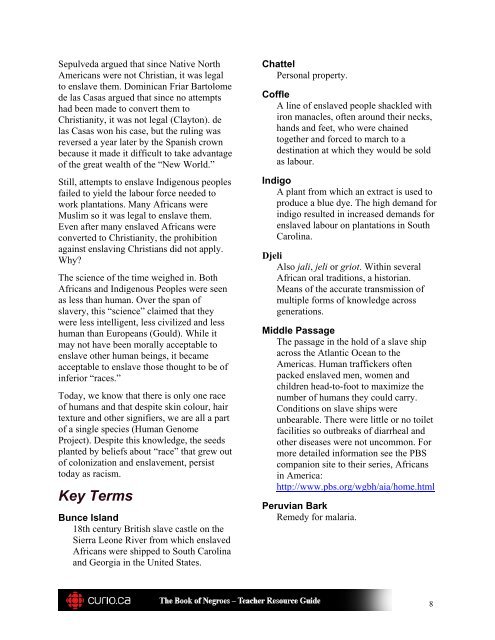ppgl2eq
ppgl2eq
ppgl2eq
Create successful ePaper yourself
Turn your PDF publications into a flip-book with our unique Google optimized e-Paper software.
Sepulveda argued that since Native North<br />
Americans were not Christian, it was legal<br />
to enslave them. Dominican Friar Bartolome<br />
de las Casas argued that since no attempts<br />
had been made to convert them to<br />
Christianity, it was not legal (Clayton). de<br />
las Casas won his case, but the ruling was<br />
reversed a year later by the Spanish crown<br />
because it made it difficult to take advantage<br />
of the great wealth of the “New World.”<br />
Still, attempts to enslave Indigenous peoples<br />
failed to yield the labour force needed to<br />
work plantations. Many Africans were<br />
Muslim so it was legal to enslave them.<br />
Even after many enslaved Africans were<br />
converted to Christianity, the prohibition<br />
against enslaving Christians did not apply.<br />
Why?<br />
The science of the time weighed in. Both<br />
Africans and Indigenous Peoples were seen<br />
as less than human. Over the span of<br />
slavery, this “science” claimed that they<br />
were less intelligent, less civilized and less<br />
human than Europeans (Gould). While it<br />
may not have been morally acceptable to<br />
enslave other human beings, it became<br />
acceptable to enslave those thought to be of<br />
inferior “races.”<br />
Today, we know that there is only one race<br />
of humans and that despite skin colour, hair<br />
texture and other signifiers, we are all a part<br />
of a single species (Human Genome<br />
Project). Despite this knowledge, the seeds<br />
planted by beliefs about “race” that grew out<br />
of colonization and enslavement, persist<br />
today as racism.<br />
Key Terms<br />
Bunce Island<br />
18th century British slave castle on the<br />
Sierra Leone River from which enslaved<br />
Africans were shipped to South Carolina<br />
and Georgia in the United States.<br />
Chattel<br />
Personal property.<br />
Coffle<br />
A line of enslaved people shackled with<br />
iron manacles, often around their necks,<br />
hands and feet, who were chained<br />
together and forced to march to a<br />
destination at which they would be sold<br />
as labour.<br />
Indigo<br />
A plant from which an extract is used to<br />
produce a blue dye. The high demand for<br />
indigo resulted in increased demands for<br />
enslaved labour on plantations in South<br />
Carolina.<br />
Djeli<br />
Also jali, jeli or griot. Within several<br />
African oral traditions, a historian.<br />
Means of the accurate transmission of<br />
multiple forms of knowledge across<br />
generations.<br />
Middle Passage<br />
The passage in the hold of a slave ship<br />
across the Atlantic Ocean to the<br />
Americas. Human traffickers often<br />
packed enslaved men, women and<br />
children head-to-foot to maximize the<br />
number of humans they could carry.<br />
Conditions on slave ships were<br />
unbearable. There were little or no toilet<br />
facilities so outbreaks of diarrheal and<br />
other diseases were not uncommon. For<br />
more detailed information see the PBS<br />
companion site to their series, Africans<br />
in America:<br />
http://www.pbs.org/wgbh/aia/home.html<br />
Peruvian Bark<br />
Remedy for malaria.<br />
8


